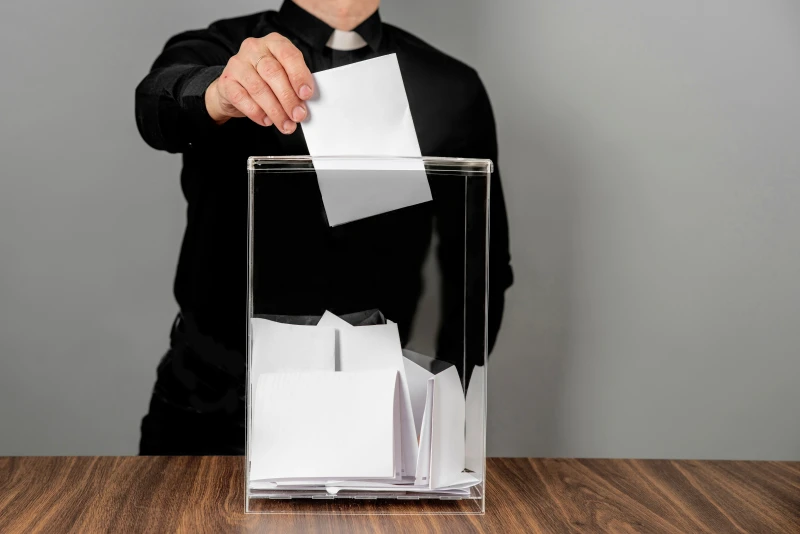

null / Credit: RasyidArt, Shutterstock
CNA Staff, Nov 4, 2025 / 06:30 am (CNA).
Catholic schools are faring much better in dioceses in which state-funded voucher programs are available for parents to use to pay school tuition, one researcher has found, though enrollment is still declining in most places.
John F. Quinn, a historian at Salve Regina University in Rhode Island, examined six Catholic dioceses over the last 16 years — three in states with voucher programs and three in states without them — and found that parochial schools are benefiting from vouchers.
He presented his research at the Society of Catholic Social Scientists’ annual conference at Franciscan University of Steubenville, Ohio, in October.
Quinn found that since 2009, the dioceses of Providence, Rhode Island; Fall River, Massachusetts; and Rockford, Illinois — none of which are located in states with voucher programs — have seen school closures and drops, some very large, in their parochial school enrollment.
Providence schools have seen a two-thirds drop, from 16,000 students in 2009 to about 10,000 in 2025, according to the historian.
The Diocese of Fall River, meanwhile, saw a 36% drop in enrollment, going from 7,800 students in 2009 to 5,000 in 2025. Rockford’s diocese saw a precipitous 52% drop, with 15,500 students in 2009 and 7,400 today. All three dioceses also saw multiple parochial school closures.
The numbers are very different in the dioceses in states that have voucher programs.
According to Quinn, the Archdiocese of Indianapolis only saw its enrollment numbers drop 3% since 2009. Nearly 23,000 were enrolled in its parochial schools in 2009, and the number stands at 22,300 today. The overall population of the archdiocese has also dropped 5% over the same time period, he noted.
Indiana’s Choice Scholarship Program was launched in 2011 and expanded to nearly all residents in 2025.
Two other dioceses, Orlando and Venice, are both in Florida, a state that approved its voucher program in 1999 and expanded it significantly in 2023.
The Diocese of Orlando has seen a 13% drop, going from 14,500 students in 2009 to 12,750 in 2025.
The Diocese of Venice, a relatively new one established in 1984, has seen a 52% increase in parish school enrollment since 2009 and growth in its number of parochial schools. In 2009, 4,400 students attended three high schools and 10 elementary schools, and today there are four high schools and 12 elementary schools with an enrollment of 6,800.
Quinn acknowledged that Florida has a growing population but said even taking that into account, the voucher programs have indisputably aided the Catholic schools there.
“We are full up with nearly every school at capacity,” Father John Belmonte, SJ, Diocese of Venice Superintendent of Catholic Education, said in September.
History of parochial schooling
“America’s Catholic leaders have long seen parochial schools as critical to the well-being of the Church in America,” Quinn noted.
He recalled the Third Plenary Council of Baltimore in 1884, at which the bishops “called for every parish to have a school and for all Catholic parents to send their children” to them.
Quinn noted that pastors would sometimes build a parish school first before completing the church building.
In 1965, the high point of parochial school enrollment, 52% of American Catholic children, or 5.2 million students, were enrolled at 13,000 Catholic grammar and high schools.
Quinn cited the National Catholic Educational Association’s annual report, released in the spring, that showed just under 1.7 million students are currently enrolled in the nation’s current 8,500 parochial schools.
In 1965, nearly 70% of all parochial school teachers, or 115,607, were religious sisters, priests, or brothers, according to the Cardinal Newman Society.
By 1990, only 2.5% of parochial school faculty were priests or religious, and that number remains the same today.
Quinn said costs started rising as more lay teachers replaced religious and priests in the classroom.
Read More![Missouri court says man can sue St. Louis Archdiocese over abuse he repressed for decades #Catholic
The Cathedral Basilica of St. Louis. / Credit: legacy1995/Shutterstock
CNA Staff, Oct 16, 2025 / 11:48 am (CNA).
A Missouri appeals court has ordered that an alleged victim of clergy sexual abuse can sue the Archdiocese of St. Louis, ruling that an arcane aspect of bankruptcy law does not negate the archdiocese’s potential liability for abuse that the plaintiff allegedly repressed for decades.The case touches on both the complex character of U.S. bankruptcy statutes as well as the often-protracted nature of abuse allegations, which frequently only come to light years or decades after the abuse is alleged to have occurred. In its Oct. 14 ruling, the Missouri Court of Appeals, Eastern District, said the alleged victim, John Doe, claims to have been abused at the St. Joseph’s Home for Boys in the late 1980s. Doe alleges that Father Alexander Anderson, who was assigned as a counselor to the home, sexually abused him; the plaintiff said he “reported the abuse [but] no action was taken,” according to the court. Doe “alleged he repressed his memory of the abuse until 2016,” the court said. He ultimately filed suit against the archdiocese in August 2022. The archdiocese argued in response that Doe’s abuse claim was effectively negated by two bankruptcy claims he had filed in 2008 and 2009. U.S. law dictates that when debtors file for bankruptcy, they create “an estate that includes nearly all of the debtor’s legal or equitable interests in property,” including legal causes of action. The archdiocese claimed that since Doe did not list his abuse claims as “exempted assets” in his bankruptcy proceedings, they became part of that “estate” and can only be administered by the trustee that handled those proceedings. The appeals court rejected the archdiocese’s argument, reversing a lower court decision and holding that Doe’s “cause of action” only arose when he said he remembered the alleged abuse in 2016, “well after” his bankruptcy filings. Doe’s standing to sue “did not accrue [when] the sexual abuse was allegedly committed” but rather when it was “capable of ascertainment,” the court held. The court’s ruling cited Missouri Supreme Court precedent, which holds that, in some cases of abuse, “the victim may be so young, mentally incompetent, or otherwise innocent and lacking in understanding that the person could not reasonably have understood that substantial harm could have resulted from the wrong.”The St. Louis Archdiocese did not immediately respond to a request for comment on the ruling on Oct. 16. This is not the first instance in which the archdiocese has been held accountable for abuse allegations that an alleged victim claimed to have repressed for decades.In 2023 the archdiocese agreed to pay a $1 million settlement to a man who said he was abused by Father Gary Wolken in the mid-1990s but repressed the memories until he was an adult. Wolken was in prison from 2003 to 2015 for sexually abusing another boy in the St. Louis area from 1997 to 2000.](https://unitedyam.com/wp-content/uploads/2025/10/missouri-court-says-man-can-sue-st-louis-archdiocese-over-abuse-he-repressed-for-decades-catholic-the-cathedral-basilica-of-st-louis-credit-legacy1995-shutterstockcna-staff-oct-16-2025.webp)


